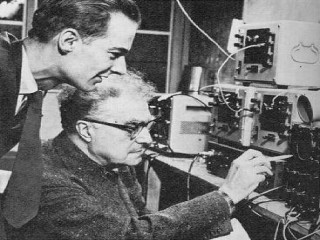
Edgard Varèse biography
Date of birth : 1883-12-22
Date of death : 1965-11-06
Birthplace : Paris, France
Nationality : French
Category : Famous Figures
Last modified : 2011-02-28
Credited as : Composer, electronic resources,
Edgard Varèse (1883-1965), French-American composer, was one of the major prophets of the new music after World War II. In 1958 John Cage wrote, "More clearly and actively than anyone else of his generation he established the present nature of music."
Edgard Varèse was born in Paris of a Corsican family, but his youth was spent in Italy, where he received an engineer's training and degree. He was equally interested in music, and after preliminary study at the Turin Conservatory, he continued at the Schola Cantorum in Paris under Vincent d'Indy and Albert Roussel and at the conservatory under Charles Widor. He was a brilliant student and won a composition prize sponsored by the city.
In 1907 Varèse moved to Berlin, where he came under the influence of Richard Strauss and Ferruccio Busoni. He conducted a chorus and wrote an opera, Oedipus und die Sphinx, with a libretto by Hugo von Hofmannsthal. Varèse also wrote a symphony which was performed, but all of these early compositions were destroyed in a fire.
With the outbreak of World War I, Varèse went to the United States. At first he was active as a conductor and as a propagandist for new music. He founded the International Composers' Guild and presented first performances of important contemporary pieces. In the following years he composed a series of very noisy compositions that baffled the critics but were acknowledged as landmarks of new music 30 years later. In these works Varèse went beyond the most advanced use of melody, rhythm, harmony, form, and instrumentation to create startlingly novel sounds.
During the 1920s Varèse wrote Ameriques, Offrandes, Octandre, Hyperprism, Integrales, and Arcana. Octandre (1924), for seven wind instruments and double bass, is a good example of his unconventional use of instruments and his new concept of musical form. The strident and extremely dissonant blocks of sound, almost resembling factory whistles, form the content of the piece without the rhythmic or tonal developments normally used by composers. Integrales (1925), for wind instruments and percussion, also suggests big-city sounds. The first section consists of two unchanging chord structures around which a melodic pattern oscillates. It is one of the first of those "crystal" musical forms that were to be used so much in the following years. This term implies that the basic sound material of the piece is unchanging and that the shifting relationships between its elements is the only thing that "happens."
In the 1930s Varèse wrote Ionisation, Metal, Density 21.5, and Equatorial, of which Ionisation (1931) is best known. Written for percussion instruments plus a siren, it is one of the first of the many all-percussion pieces that were to follow. Equatorial, calling for two Theremins, shows his interest in new sound sources.
In 1937 Varèse stopped composing because he was no longer interested in seeking new sounds in conventional instruments; it was not until the tape recorder and electronic music became available that he finally gained the vast new sound resource he had been seeking. His mature works, utilizing noises and electronically produced sounds, are Deserts (1954) and the Poème electronique (1958). Deserts has two basic sound groups. The first is produced by the instruments; the second consists of a two-channel stereophonic tape of electronically produced sound. According to the composer, the instrumental parts produce a sense of movement in space, associated with the element within which the human operates, and the taped section is associated with distance and the nonhuman elements of the universe.
The Poème electronique was written to be performed in the Phillips Pavilion at the 1958 World's Fair in Brussels. The pavilion was planned as a "total environment" meant to result in a complex, multimedia experience for the audience. The music was heard from over 400 loudspeakers as the visitors walked through the building, seeing at the same time a series of projected images. Varèse's music consists of a combination of taped "natural" sounds, such as bells and voices, and noises such as clicks and motor roars. It is not meant to be listened to in the usual attentive manner.
Varèse's contributions to music are his widening of the material of music to include noise as well as "musical" sound, his development of new ways of organizing musical compositions, and writing of music to be heard as a part of an environment. All of these revolutionary ideas proved to be of great importance to the composers of the so-called avant-garde of the 1950s and 1960s.
















